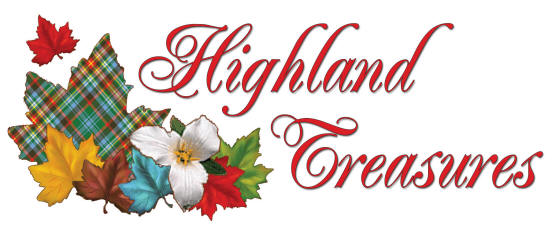The Highlands of Haliburton Tartan was commissioned by the Haliburton County Chamber of Commerce. The tartan was designed by Ms. Patricia Jenkins of The Loomcrofters Weavers, Gagetown, NB and registered in 1963.
Ms. Jenkins assisted in the design and the registration of the Royal Canadian Air Force (RCAF) tartan in 1943. The RCAF tartan was the first from outside the United Kingdom to be recorded at the Court of Lord Lyon in Edinburgh. Miss Jenkins designed other registered tartans, including the New Brunswick provincial tartan (1959), City of Fredericton (1961), Fredericton Kinsmen, Saskatchewan Shriners, International Lions (1962), the Town of Oromocto, and the Highlands of Haliburton (1963).

The colours of the Highlands of Haliburton tartan were chosen to represent the green of the forests; blue of the lakes; white for both the snow and the provincial flower, the Trillium; the red and gold for the splendour of the fall colours; brown for both the earth and the fur bearing animals, and the work of the early pioneers.
The Highlands of Haliburton tartan was woven in Scotland and ordered regularly every few years up until the mid-1980’s, usually in a light-weight 100% wool. So far little paperwork from 1963 to 1973, and after 1979 has been located to document the ordering of tartan. A letter of inquiry regarding price was issued in 1986 but nothing indicates if tartan was actually ordered.
The Highlands of Haliburton Tartan was woven in Scotland by Peter MacArthur & Sons (Clan Weaving Mills) in Hamilton, Scotland. Paperwork shows an enquiry for more tartan was submitted to Peter MacArthur & Co. Ltd (Clan Weaving Mill) in March of 1973. The letter received back from the mill stated that due to the rise in popularity of tartan for “fashion”, the delivery of a bolt of fabric would extend into November 1973 – far beyond their normal delivery expectations. The letter goes onto state that the finer cloth supplied previously in September 1970 was no longer available, and a heavier weight fabric was being recommended (Class 20, 60” wide, 9.5oz).
Bolt fabric, 59" wide was ordered every two or three years and both the weight of cloth available and the price per yard changed each time. The first fabrics were very light-weight...almost like fine shirt fabric. The price in 1973 was £1.90 per yard ($4.47 Cdn), retailing for $7.50; and by the early 1980's it was over £15.85 per yard to purchase, retailing locally for $22.50 per yard. In the late 1970's Peter MacArthur & Sons had arranged with Harper's, located in Montreal to act as their agent here in Canada. Harper's was a company well established as a supplier of suiting fabric to the fashion industry, and became the main supplier of a wide variety of tartan fabrics.
In 1986 the Chamber of Commerce inquired about the cost of a bolt of fabric, and although it is assumed one was purchased, currently no paper has yet to be located providing the purchase details. This fabric was available for purchase throughout the county up until the early 1990's when the small remaining amount was sold; but no further purchases have been made.
Even though no current record can be found for the business that was Peter MacArthur & Sons; Harper's is still in business and continues to supply a limited number of tartans in light-weight polyester blends.
For those with a weavers interest, the 9.5 oz cloth received in January 1974 was of 100% pure new wool, 2/50’s worsted count for warp, 16 ½ worsted count for weft, 55 EPI warp, 46 PCI weft, with a mill finish; and a total yardage of 248.5 yards at 1.90 GBP (pound sterling. The fabric was sent from Glasgow, Scotland to a Toronto brokerage firm on the ship “Dart America”, January 1974. The package was then sent via CN Express from Toronto to Lindsay, Ontario in February 1974.

Many articles were made from the tartan, including kilts, clothing, and drapes, etc. It is known that one man even painted the roof of his car in tartan! In 1971 orders were placed with a Niagara Falls company to make numerous products for sale. These designs included a clutch purse, vanity purse, key case, men’s billfold, eye glass case, pencil case, breast pocket wallet with insert, file/comb/mirror case, stein, and a flask...just to name a few.
Many places either ordered tartan, or sold tartan and a few of them were the Legion Pipe Band, Carnarvon Gift Centre, Ontario Place Committee for Centennial Choir, Stedman’s (Haliburton), Minden Furniture Mart, and St. Paul’s Anglican Church.
Notes in file indicated that the fabric ordered from the mill in 1973 was £1.90/Yd ($4.47Cdn), £8.90/yd in 1977, £15.85 in 1979, and by 1986 it sold locally for $25/metre. All of this was 60” wide fabric. This fabric can still be custom ordered from the United Kingdom, in an 11oz weight 100% Wool, for $81.75/ metre and $89.93/metre for the 16oz wool. Tartan can also be purchased in 3oz Silk at $130.80/metre, These fabrics require a 4 metre minimum, with the understanding that all fabric woven now is usually “single width” meaning it could be 28” wide to 32” wide depending on the mill. The single width fabric is suitable for kilts, scarves, sashes, ties, and vests; and the wider fabric now called “double width” is usually 56”. A kilt can take anywhere from 4 to 8 yards of fabric, depending on the clothing size and style of pleats....so be prepared to pay a significant amount if the cloth is single width!

